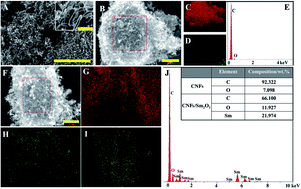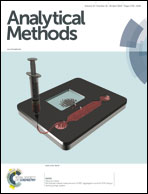A carbon nanofibers–Sm2O3 nanocomposite: a novel electrochemical platform for simultaneously detecting two isomers of dihydroxybenzene†
Abstract
In this report, a CNFs-Sm2O3 nanocomposite modified glassy carbon electrode (CNFs-Sm2O3/GCE), comprising CNFs with a large specific surface area and Sm2O3 with excellent catalytic activity, is prepared as a novel sensor for simultaneously detecting hydroquinone (HQ) and catechol (CC) in an aqueous environment. The surface characteristics and electrochemical performance of the as-prepared sensor were characterized by scanning electron microscopy (SEM), energy dispersive spectroscopy (EDS), X-ray diffraction (XRD) and electrochemical approaches. The electrochemical results show the well-defined redox peaks of HQ and CC, and the potential difference of the peak-to-peak separation between HQ and CC is about 111 mV, as determined by both cyclic voltammetric (CV) and differential pulse voltammetric (DPV) techniques, which indicate that the modified electrodes can simultaneously determine HQ and CC without any separation step. The current of the anodic peak response of the CNFs-Sm2O3/GCE displays a linear dependence on the concentration of HQ and CC in the range of 1–500 μM, and the detection limits for HQ and CC are 0.09 and 0.07 μM, respectively. Moreover, the CNF-Sm2O3/GCE possesses excellent selectivity, reproducibility and stability in determining the concentration of the isomers of dihydroxybenzene. Therefore, this new type of electrode is promising as a sensor for simultaneous determination of HQ and CC in an aqueous environment.



 Please wait while we load your content...
Please wait while we load your content...